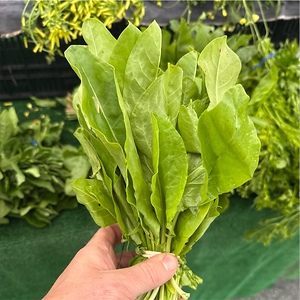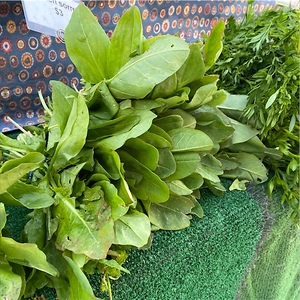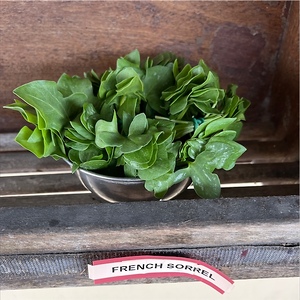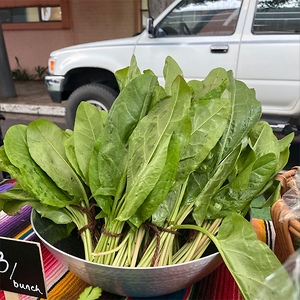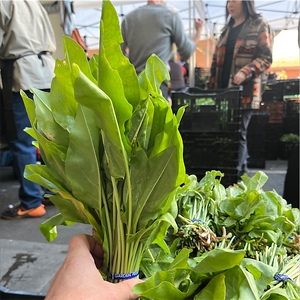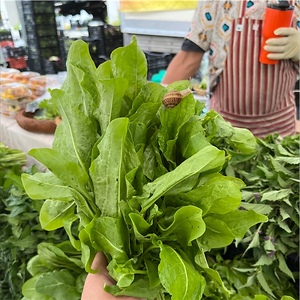


French Sorrel
Estimated Inventory, bunch : 0
This item was last sold on : 01/29/25
Description/Taste
French sorrel grows in thick, dense clusters of upright leaves, averaging 5 to 10 centimeters in length. Each leaf's shape ranges from slightly rounded to long, broad, and flat, often described as having a shield-like appearance. The leaves are bright green, semi-smooth, pliable, and lightly wrinkled with a wavy nature. Prominent veining travels across the surface, and the stems are straight, cylindrical, slender, and light green. French sorrel has a crisp and succulent consistency when raw. As the leaves are cooked, they develop a softer, silkier feel like spinach. French sorrel is edible raw or cooked and can be harvested at multiple stages of maturity. The species is known for its sharp, tangy, and bright flavor with an acidity reminiscent of lemons, kiwis, and green apples. French sorrel can also develop subtle bitter notes late in its season and sometimes contain earthy, green, and vegetal undertones.
Seasons/Availability
French sorrel is available in the early spring through mid-summer. If grown in greenhouses, the species may be found year-round.
Current Facts
French sorrel, botanically classified as Rumex scutatus, is an herbaceous perennial belonging to the Polygonaceae family. The low-growing, creeping species reaches 25 to 60 centimeters in height and is a hardy plant known for its ability to thrive in wild landscapes and home gardens. French sorrel is one of several types of sorrel cultivated for culinary use. It is important to note that French sorrel is a separate species from Garden sorrel, or Rumex acetosa. Both species can be used almost interchangeably in recipes, but have slightly different flavors and leaf shapes. French sorrel has a wavy, shield-like shape, while Garden sorrel has a straighter spear shape. Throughout history, French sorrel has been foraged from wild populations and planted in herb gardens as a flavoring in culinary preparations. The species is harvested as a baby green for raw dishes or picked at maturity for cooked recipes. French sorrel is favored for its ability to add bright notes to dishes to elevate the overall complexity and depth.
Nutritional Value
French sorrel is a source of potassium to balance fluid levels within the body and iron to develop the protein hemoglobin for oxygen transport through the bloodstream. Sorrel also contains vitamins A, C, D, E, and K to maintain healthy organ functions, strengthen the immune system, guard the cells against the damage caused by free radicals, and aid in faster wound healing. In natural medicines, French sorrel is believed to help with digestion. The species also has anti-inflammatory properties and is sometimes used in topical treatments to soothe skin irritations. Sorrel contains oxalic acid, a naturally occurring organic compound that gives the leaves their sour taste. Oxalic acid is harmful if ingested in large quantities. Only consume small amounts of French sorrel raw. Cooking helps to lessen the amount of oxalic acid in the leaves.
Applications
French sorrel has a tangy, sour, and vegetal taste suited for raw and cooked preparations. The greens are used in dishes where a pop of bright acidity would be enjoyed, and are commonly added to salads as a fresh ingredient. When slicing sorrel, it is recommended to use a stainless-steel knife as the leaf’s acid content can discolor other blades. French sorrel can be gently torn and incorporated as an herb into slaws, grains, and greens, or it can be folded into butter as a spread for fish and bread. In Europe, French sorrel is popularly blended into seasonal spring pesto or added to yogurt or cream-based dips. It is also pureed into green sauces and served with meats like duck, veal, goose, and fish. Only young and tender French sorrel leaves should be used for raw preparations in small quantities. Larger, more mature leaves are reserved for cooked preparations. When heating French sorrel, the leaves may transform to brown or olive-green hues. French sorrel is added to seafood dishes, mixed with stuffing for meat, or cooked into egg-based dishes. The greens can also be added to pasta, cooked into gratins, or baked into cheese tarts. In France, sorrel is notably used in chilled or heated soups with cream, stock, and onions. The brightness of the greens also complements savory potato dishes. Worldwide, sorrel has expanded beyond its native range and is grown as a culinary herb for adding sour nuances to dishes. French sorrel is frequently used in savory meals, but it is also used in small amounts in sorbet, frostings, and other sweet desserts as a balancing flavor. French sorrel pairs well with lentils, potatoes, leeks, spinach, aromatics such as garlic, onions, and shallots, herbs including parsley, tarragon, mint, chervil, and dill, and spices like nutmeg, cinnamon, and allspice. Whole, unwashed greens should be immediately used for the best quality and flavor. The leaves will last for several days, depending on maturity and harvest date, when wrapped in a damp paper towel and stored in a container in the refrigerator. French sorrel can also be frozen or dried for extended use.
Ethnic/Cultural Info
Sorrel is famously used in the French dish saumon à l'oiselle, or salmon with sorrel sauce, a recipe created by the Troisgros brothers in the late 20th century. The culinary legacy of the Troisgros family began in 1930 with the Troisgros brothers’ parents, Jean-Baptiste and Marie Troisgros. The couple purchased Hôtel des Platanes in the commune of Roanne in Central France and renamed it Hôtel Moderne. The establishment became a popular spot for traveling workmen and seasonal tourists, and in the 1950s, sons Jean and Pierre Troisgros, also known as the Troisgros brothers, took over the family business. The Troisgros brothers focused on allowing ingredients to reveal their authentic flavor in dishes and received their first Michelin star in 1956. They later acquired two more stars by 1968 and were well-known as some of the founding chefs of Nouvelle Cuisine. During the 1960s and 70s, a group of French chefs paved the way for a new style of cooking to contrast with the heavy nature of Haute Cuisine. Nouvelle cuisine used lighter sauces and emphasized the visual nature and true flavor of ingredients. One of the most famous dishes created during Nouvelle cuisine was saumon à l'oiselle. The dish debuted in 1973 when the Troisgros brothers served the dish for a Legion d’Honneur lunch for Paul Bocuse. Sorrel was used in the cream-based sauce and added bright, tangy flavors to the partially cooked salmon fillet. Before this dish, sorrel was often reserved for soups and green sauces in French cuisine and was rarely recognized as a staple ingredient. Saumon à l'oiselle is still prepared in the modern day and is a favored recipe using sorrel in kitchens worldwide.
Geography/History
French sorrel is native to Europe and has been growing wild since ancient times. The species thrives in temperate, mountainous regions, rocky landscapes, pastures, fields, woodlands, and partially shaded areas. The exact center of origin is unknown, but several sources hypothesize that Southern France's highland regions are one possible site of origination. Over time, French sorrel has been carried across Europe and planted in natural and planned landscapes. The species has also escaped cultivation and naturalized throughout the continent. Today, French sorrel is grown worldwide as a culinary plant, especially in Europe, Asia, and North America. The species is foraged from wild and cultivated plants, and the greens are seasonally sold as a delicacy in local farmers’ markets in their growing regions.
Recipe Ideas
Recipes that include French Sorrel. One







